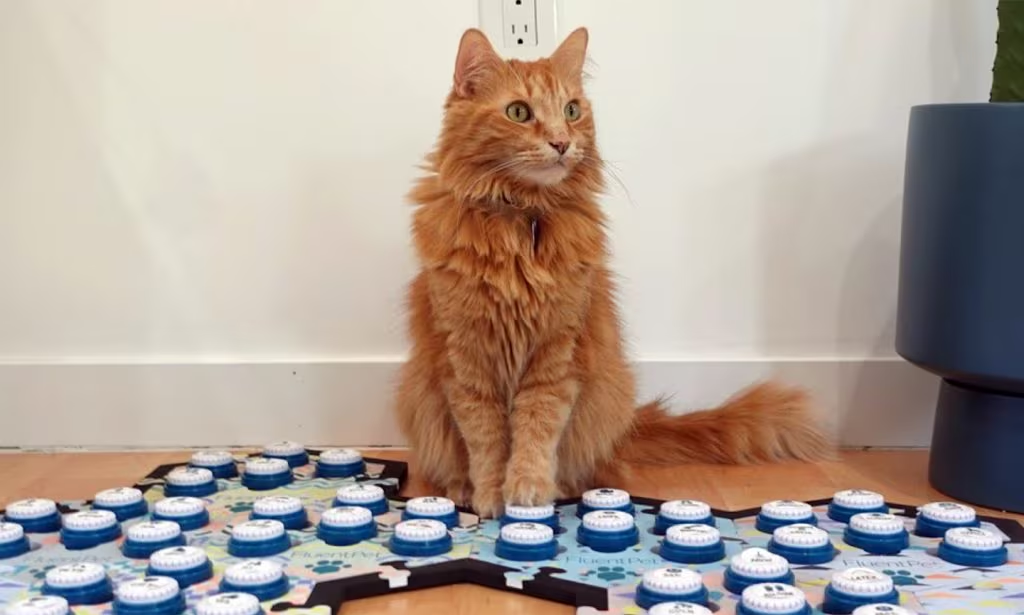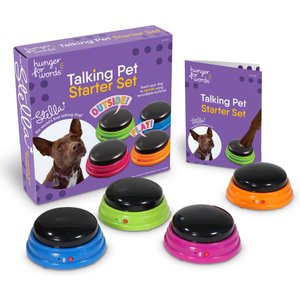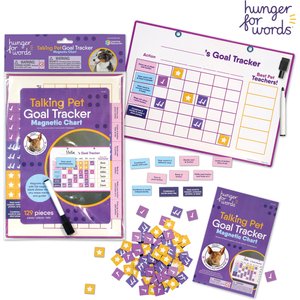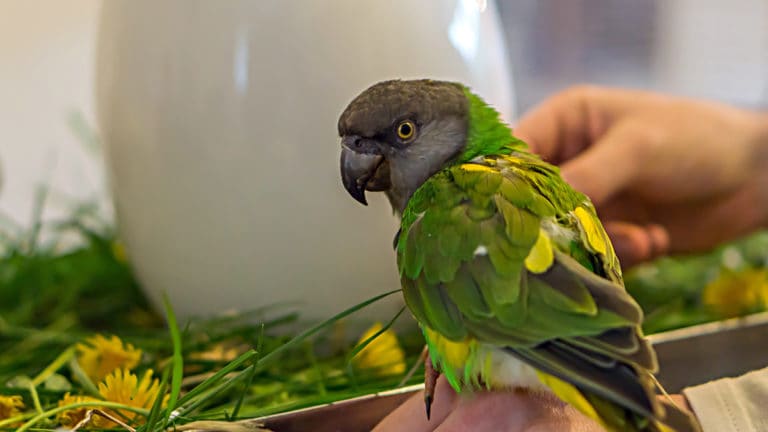You might've seen cats go viral for "talking" with buttons. There’s Justin Bieber—not the singer, but the cat who’s TikTok-famous for using these buttons, which have pre-recorded words on them, to let his parent know what he wants. (It's a toss-up between asking for scratches and asking for food.) And over on Instagram, Billi—dubbed “the most talkative feline”—also shows off her impressive way of communicating with her parents with talking buttons. Her favorite word? “Mad!”
But why merely watch cats “talk” with buttons when you can teach your cat to do the same?
Teaching your cat to talk with buttons boasts plenty of benefits: It strengthens your bond, it provides another opportunity for communication, and it stimulates their brains, which can, in turn, improve their behavior and mood (and who doesn't want that?). And the good news is, teaching cats to use speech buttons can be done in just a few simple steps. Here's how.
@justinbieberthecat_ well this scared me #fluentpet #talkingcat #justinbieberthecat ♬ original sound - Justin 🐅
Click on a button to jump to that section:
What Are Cat Buttons and How Do They Work?
Words and phrases programmed onto these recordable buttons can include anything and everything, from “food” and “play” to “love you!” Pets can even combine words together to create phrases.
For example, Justin Bieber the Cat uses the “food” and “birds” buttons together nonstop. Why? According to momager Sarah Baker, well, there’s a bird that likes to taunt him outside a window. (And yes, he’d like to enjoy it for dinner.)
Through consistent use and modeling of the buttons, cats can learn to communicate their wants, needs, thoughts, feelings, questions and observations about their environment with the press of a button.
For example, “if you say, ‘dinner time!’ and then present food consistently, your cat learns that that particular phrase means ‘food,’” explains licensed veterinary technician and animal behavior consultant Brittany Thomas, LVT, IAABC-CABC, KPA-CTP, owner of Companion Pet Behavior Solutions in Jeffersontown, Kentucky. “It’s the same [thing with] shaking a treat bag: Your cat comes running because they’ve learned to associate that sound with a particular outcome: a treat.”
Learn more about the science behind talking buttons at PetMD.
How Do I Teach My Cat to Use Talking Pet Buttons?
1Find the right buttons for you and your cat.
“Any buttons will work as long as you can record words,” says Baker. “It comes down to preference. I like the smaller buttons because you can fit more [on the floor].” Justin Bieber the Cat uses buttons set atop foam hex-tiles from FluentPet. Stella, the first widely-known dog to use talking buttons, uses Hunger for Words (created by her speech-language pathologist mom, Christina Hunger). Any brands—whether promoted as cat or dog buttons—will work.
2Start with recording a few words your cat already knows.
Thomas suggests making a short list of things your cat really enjoys, like food, catnip, toys. Once you have your list, rate your cat’s familiarity of those words on a scale of one to five, starting with the highest-rated item first.
Record the words onto the buttons making sure to record only one word per button and keeping the words as short as possible. For example, instead of “dinner time,” use “food.”
Remember that training your cat to use speech buttons is not a competition. Start with just a few buttons.
“I think people can get really hung up on the number of buttons,” Baker says. “If your pet can successfully communicate with just two or three buttons, sometimes that’s all you need. The number of buttons is not an indicator of progress or success.”
3Model the words for your cat.
Modeling words means using the buttons in the right contexts throughout the day. For example, if you’ve recorded the word “play,” press the “play” button and immediately engage your cat in playtime with one of their toys, like a wand toy, for three to five seconds, explains Thomas. Then, stop playing, hit the button again, and immediately play with your cat.
“Get in the habit of using [the buttons] all the time,” adds Baker. “If you’re doing stuff around the house, just go over and model the buttons.” The more you reinforce the buttons, the faster your cat will learn.
4Respond when buttons are “explored” or pressed.
In the beginning of the teaching journey, respond anytime your cat explores a button or uses a word (as much as possible, of course!). It’s your response to the words that teaches your cat what they mean.
Here are a couple examples of what this looks like:
- If your cat explores the button but doesn’t press it: If you see them sniffing the “play” button, go press it for them and then commence playtime.
- If your cat presses the button: If they press the “play” button, play with them.
It’s important to note that when your cat does press buttons, don’t reward them with treats. This can hurt your progress by confusing the meaning of the buttons for your cat. Instead of understanding that hitting the buttons gets them whatever the recorded word is, they’ll learn that hitting the buttons gets them extra servings of treats. And that’s not what we want.
How many words can cats learn?
It’s reported that cats can understand anywhere from 25 to 40 words. Justin Bieber the Cat, however, knows over 40 words (and is using sentences), while Billi the cat has 50 words on her board.
Cat Button Training Tips
Say "no" as needed.
A good way to set boundaries is to record a button that says “no” when pressed. This signals to your cat that you heard them, but the answer is “no,” Baker says.
For example, if your cat presses the “play” button but you’re unable to play with them (or, you’ve already played with them and they’ve pressed the button again), press the “no” button. You won’t lose the benefit of the buttons by saying “no.” Simply allowing your cat to express what they want strengthens understanding and your bond.
Don’t force it.
It’s best to let your cat choose to talk to you in their own time. So, “don’t ever pick up your pet’s paw and force them to press the button,” says Baker. Strive for learner-driven communication versus communication on-demand. This will help create a more enjoyable, less-frustrating experience for your cat.
Keep sessions short.
Due to cats’ short attention spans, it’s best to keep training sessions to about five minutes per session.
Pay attention to other natural communication cues.
“[Speech buttons] should be a tool to enhance communication,” Baker says, adding that using buttons should not be a replacement for your pet’s natural communication. “It’s really important to still [pay attention to] your cat’s body language and let them go at their own pace.”
For example, if your cat stands sideways and arches their back, they’re likely feeling angry or scared, so back off. On the other hand, if they’re pointing their head or body at you—and even staring you in the eye—they’re receptive to attention. So, give them some pets!
Get ready for some odd associations!
A unique part of the process is interpreting your pet. “They’ll use words in combination that sound kind of funky at first,” Baker says, but don’t disregard them if they continue to use the buttons in the same order, again and again. They may be trying to tell you something! (Remember the story of Bieber using “food” and “bird” buttons?)
“It can take some abstract thought sometimes,” Baker says. “But it’s really fun. You just have to listen.”
What Are the Benefits of Cat Buttons?
Allow your cat to express wishes and desires.
“[Justin Bieber the Cat] uses [the buttons] to get my attention all the time,” says Baker. “It’s a more straightforward way for him to ask for what he wants. He can be really direct and ask for food or to play.”
Strengthen your bond.
Not all cats get trained to sit, fetch, shake and roll over like their dog counterparts do. But taking the time to train your cat to use speech buttons can strengthen the bond you share.
Stimulate their brain, in turn improving behavior and mood.
Teaching your cat to use speech buttons exercises their brain and can help reduce the boredom and stress they feel. “I’ve noticed a change in his mood, [too],” Baker shares. “I feel like he’s happier. He’s less likely to misbehave or act out when he wants attention. He just lets me know what he wants.”
Speech buttons are fun, right? But you don’t need these cool communication devices to know when your cat’s trying to tell you they love you. Learn these 13 ways your cat says, “I love you,” too.
Got cat buttons? Share your progress and success with us by tagging @Chewy!
More on Cat Behavior:
Share:














